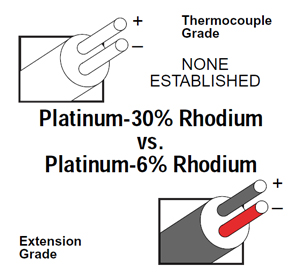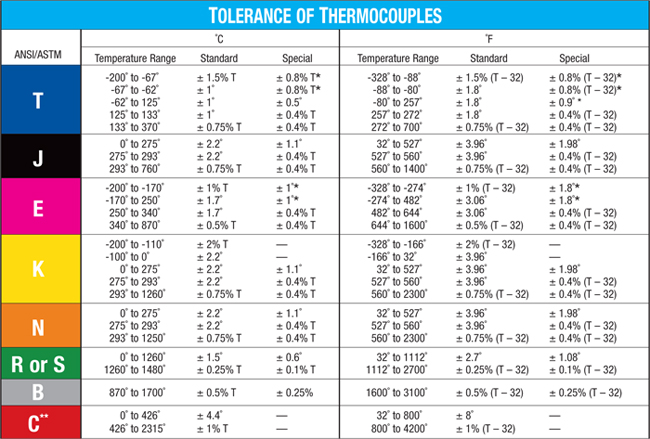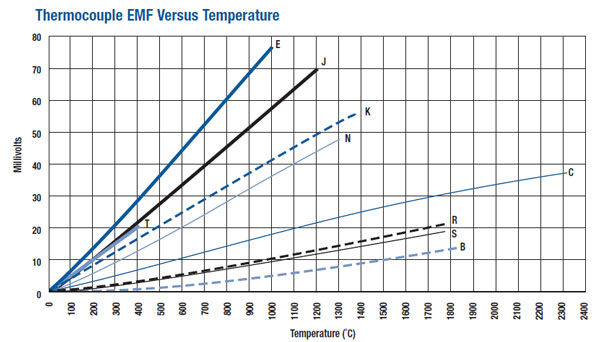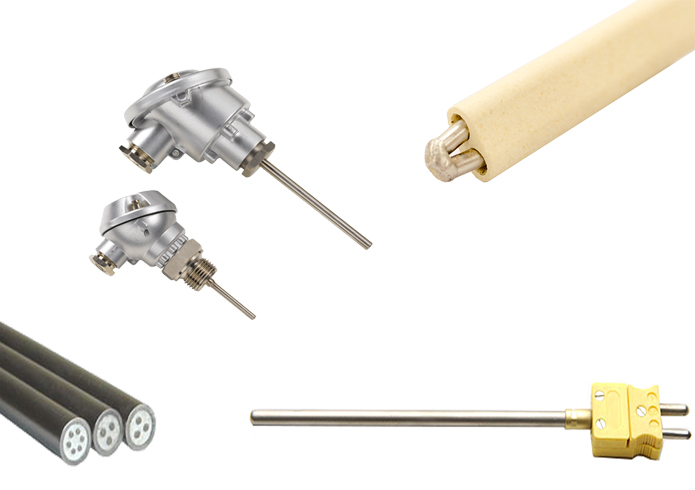Thermocouple Links
The following links are thermocouple resources
Type B Thermocouple
(Platinum/ Rhodium) 0°C to +1820°C / 32°F to +3308°F
Platinum {30% Positive Leg} Rhodium/Platinum {6% Negative Leg}

Type B thermocouples use a platinumrhodium alloy for each conductor. One conductor contains 30% rhodium while the other conductor contains 6% rhodium. These thermocouples are suited for use at up to 1820 °C. Type B thermocouples produce the same output at 0°C and 42°C, limiting their use below about 50°C.
Type B thermocouples are commonly placed in clean air / oxidizing environments but should not be used in reduction atmospheres.
The increased amount of Rhodium in the Type B thermocouple helps to reduce the grain growth problem allowing for a slightly increased temperature range as compared to the types R and S.


Type B Thermocouple Junctions
Grounded Thermocouple

This is the most common junction style. A thermocouple is grounded when both thermocouple wires and the sheath are all welded together to form one junction at the probe tip. Grounded thermocouples have a very good response time because the thermocouple is making direct contact with the sheath, allowing heat to transfer easily. A drawback of the grounded thermocouple is that the thermocouple is more susceptible to electrical interference. This is because the sheath often comes into contact with the surrounding area, providing a path for interference.
Ungrounded Thermocouple

A thermocouple is ungrounded when the thermocouple wires are welded together but they are insulated from the sheath. The wires are often separated by mineral insulation.
Exposed Thermocouples (or "bare wire thermocouples")

A thermocouple is exposed when the thermocouple wires are welded together and directly inserted into the process. The response time is very quick, but exposed thermocouple wires are more prone to corrosion and degradation. Unless your application requires exposed junctions, this style is not recommended.
Type B Thermocouple Sheath
316 Stainless Steel
Maximum temperature: 1650. Best corrosion resistance of the austenitic stainless steel grades. Widely used in the food and chemical industry. Subject to damaging carbide precipitation in 900°F to 1600°F (482°C to 870°C).
316L Stainless Steel
Maximum temperature: 1650°F (900°C). Same as 316 SST (04) except low carbon version allows for better welding and fabrication.
304 Stainless Steel
Maximum temperature: 1650°F (900°C). Most widely used low temperature sheath material. Extensively used in food, beverage, chemical and other industries where corrosion resistance is required.
Industry: Subject to damaging carbide precipitation in 900 to 1600°F (480 to 870°C) range. Lowest cost corrosion resistant sheath material available.
304L Stainless Steel
Maximum temperature: 1650°F (900?C). Low carbon version of 304 SST (02). Low carbon content allows this material to be welded and heated in the 900 to 1600°F (480 to 870°C) range without damage to corrosion resistance.
310 Stainless Steel
Maximum temperature: 2100?F (1150?C). Mechanical and corrosion resistance, similar to but better than 304 SS. Very good heat resistance.
This alloy contains 25% chromium, 20% nickel. Not as ductile as 304 SS.
321 Stainless Steel
Maximum temperature: 1600°F (870°C). Similar to 304 SS except titanium stabilized for intergranular corrosion.
This alloy is designed to overcome susceptibility to carbon precipitation in the 900 to 1600°F (480 to 870°C) range. Used in aerospace and chemicalapplications.
446 Stainless Steel
Maximum temperature: 2100°F (1150°C). Ferritic stainless steel which has good resistance to sulfurous atmospheres at high temperatures.
Good corrosion resistance to nitric acid, sulfuric acid and most alkalies. 27% chromium content gives this alloy the highest heat resistance of any ferritic stainless steel.
Inconel 600
Maximum temperature: 2150°F (1175°C). Most widely used thermocouple sheath material. Good high temperature strength, corrosion resistance, resistance to chloride-ion stress corrosion cracking and oxidation resistance to high temperatures.
Do not use in sulfur bearing environments. Good in nitriding environments.
Inconel 601
Maximum temperature: 2150°F (1175°C) continuous, 2300°F (1260°C) intermittent. Similar to Alloy 600 with the addition of aluminum for outstanding oxidation resistance. Designed for high temperature corrosion resistance.
This material is good in carburizing environments, and has good creep rupture strength. Do not use in vacuum furnaces! Susceptible to intergranular attack by prolonged heating in 1000 to 1400°F (540 to 760°C) temperature range.
Inconel 800
Maximum temperature: 2000°F (1095°C). Widely used as heater sheath material. Minimal use in thermocouples. Superior to Alloy 600 in sulfur, cyanide salts and fused neutral salts.
Susceptible to intergranular attack in some applications by exposure to the temperature range of 1000 to 1400°F (540 to 7607deg C).
How to measuere temperature with a Type B Thermocouple
A thermocouple circuit contains the two alloy junctions, wire sand connectors and a voltage measuring device. When the two junctions are experiencing different temperatures, measurable current flows through the circuit. The current is related to the temperature differential. Because the measurement is relative, one of the temperatures must be known in order to calculate an absolute temperature. In early thermocouples, one junction was kept at 0° C by immersing it in an ice water bath. Today, one of the junctions, the "cold junction," is electrically compensated to maintain a standard. The other junction, the "hot junction," is exposed to the environment to be measured.
Collecting data from a type B thermocouple
A Type B thermocouple can be connected to a voltmeter for simple data collection. In this case, the output is a voltage, and the reader has to convert the voltage level to temperature using a conversion formula. To record data, the thermocouple can be connected to a data logger or a data acquisition system to store collected data. In these cases, a conversion circuit or a software operation can be used to calculate the temperature using the voltage output.



